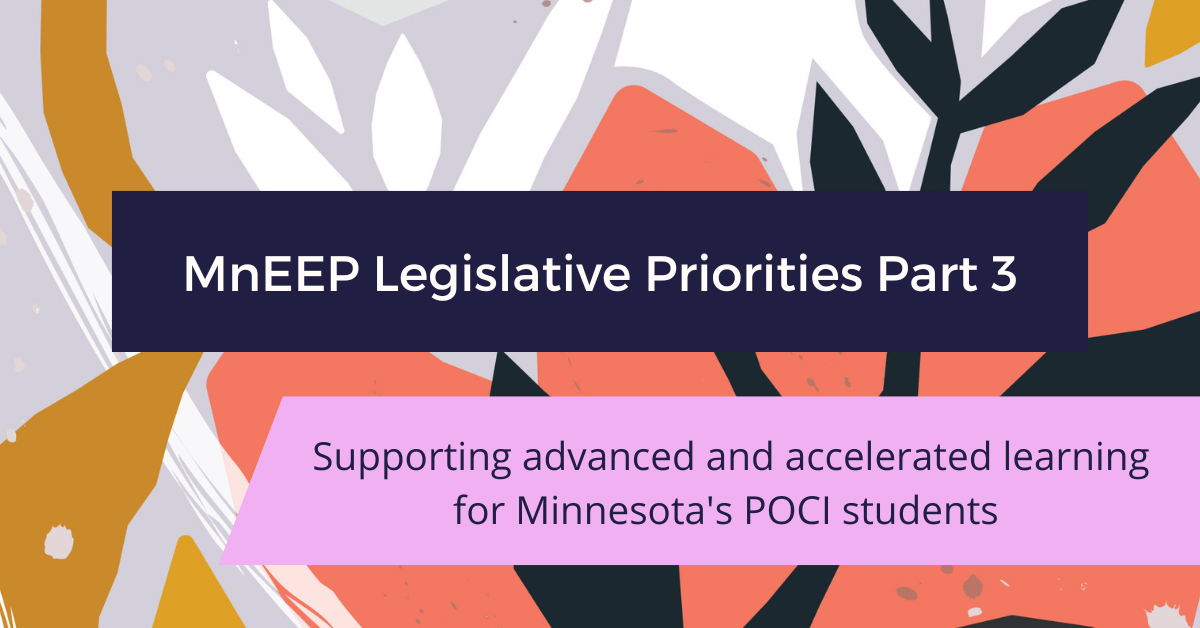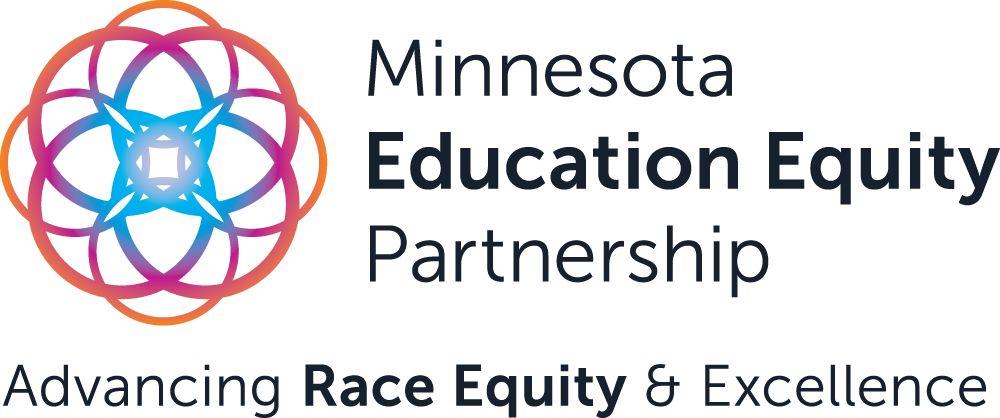
MnEEP Legislative Priorities Part 3: Supporting advanced learning for POCI students
Race Equity for Accelerated Learning (REAL) is a crucial plan for removing barriers to academic excellence for Minnesota’s POCI students.
This legislative session, with Governor Walz and his cabinet working to build the “best state in the country for kids,” we have a critical opportunity to build innovative, evidence-based models for a more racially equitable school system in Minnesota.

Playing “catch up” to reduce the deep racial disparities in Minnesota isn’t enough. We must build a system that truly supports racially equitable educational opportunities—including opportunities for all students to excel through academic excellence and social and emotional, relational, and mental well-being.
Race Equity for Accelerated Learning (REAL) is a crucial plan for removing barriers to academic excellence for Minnesota’s POCI students.
We support removing these barriers and building new, equitable REAL models to build racial justice in Minnesota’s middle schools and high schools in three ways:
1. Expand Post-Secondary Enrollment Options (PSEO) to all students who qualify for extended day, week, and/or year.
What this means:
PSEO allows students to earn college credits for career and technical education and college credits for free while attending high school during their 10th, 11th, and 12th-grade years through students taking college-level courses in a tech school, college, and/or university setting.
However, students who attend Alternative Learning Programs (ALPs) and Alternative Learning Centers (ALCs), or alternative/non-traditional high schools like contract alternatives, are not often encouraged to avail themselves of this opportunity to pursue college credits, leaving the possibility for academic acceleration and excelling beyond high school requirements out of reach for these students.
Why this matters:
Today, nearly 160,000 students access alternative education on a part-time or full-time basis. This represents about 18 percent of Minnesota public school students.
These centers/programs—designed for students who are considered “at-risk,” by statute, in traditional education environments—are disproportionately People of Color and Indigenous (POCI) students.
This is another way Minnesota’s school systems are structured to support accelerated learning and education opportunities for majority white, middle-income students while holding onto barriers to college access and completion for POCI students.
To build a racially equitable school system in Minnesota, all schools, including ALPs and ALCs, must provide the same opportunities for students to explore advanced or accelerated learning and increase their participation.
Why now:
Removing this barrier for ALC students is critical to building a racially just education system in Minnesota. Each student—not just privileged students—should have the opportunity to build their education pathway beyond high school requirements.
Research shows that graduation incentives and opportunities to experience advanced coursework outside of high school increase college access and completion rates for POCI students.
Minnesota must end this cycle now and build racially equitable pathways to educational excellence for all students.
2. Expand “extended time revenue” to include community grants for Minnesota’s Graduation Incentives Program.
What this means:
Minnesota’s Graduation Incentives Program was created in 1987 to provide incentives for students who have experienced difficulty in the traditional education system.
The law is designed specifically for students ages 16-21, who are struggling in school because of personal, legal, or health situations; who are behind in credits or are making slow academic progress; or who have been out of school for some time.
“Extended time revenue” provides additional money to school districts participating in State-Approved Alternative Programs (SAAPs), under the policy umbrella provided by the Graduate Incentives Program.
SAAPs are delivered through Area Learning Centers (ALCs), Alternative Learning Programs (ALPs), targeted services activities, and through contract alternative schools.
To advance racial equity, a district’s “extended time revenue” should be used to support and manage, in partnership with community engagement and oversight, grants for developing partnerships with nonprofit and community-based organizations to develop innovative programs that more equitably meet the needs of students who are eligible for the Graduation Incentives Program.
Why this matters:
Community-centered and community-based learning is essential for advancing education equity for POCI students.
Community-based learning provides opportunities for students to connect with their unique identity, heritage, language, and culture, while also supporting community connections and emotional and social well-being.
Why now:
The Minnesota Legislature has a target goal for 2025 that 70 percent of Minnesota adults ages 25 to 44 will have a postsecondary certificate or degree.
To get there, we need to take bold action now to undo systemic inequities in Minnesota’s high schools and higher ed systems and design models to increase college access and completion for Minnesota’s growing number of POCI students.
Minnesota cannot increase college access and completion without centering the human dignity and unique talents and aspirations of each student in all education spaces.
Building community-led and community-based learning models embrace the experiences, history, knowledge, culture, and assets of each student while deepening their self-enrichment and community.
This is how we build equitable learning models where each student can achieve their full potential.
3. Expand the Graduation Incentives Program to more students.
What this means:
- Students with limited and/or Interrupted Formal Education (SLIFE) Learners should automatically qualify for the Graduation Incentives Program.
- Pre-K students who are enrolled in the final year of a prekindergarten program and have been identified as needing additional academic and enrichment supports should automatically qualify for the Graduation Incentives Program.
- Students who are eligible to receive free and/or reduced-priced meals or some other indicator of lower socioeconomic status (SES) as a qualifying student group to the Graduation Incentive Program.
Why this matters:
Including students who need a “boost” so that they can experience “accelerated learning” and earn some college credits prior to high school graduation is morally and racially just, and socioeconomically the smart thing to do for and with Minnesota’s POCI students.
Minnesota needs to create real policies that open up greater access to accelerated learning sooner and especially so for POCI learners:
- Maximize dual enrollment in MN;
- Expand access to summer learning and PSEO; and
- Create the most racially equitable P-20 system in the country here in Minnesota.
Why now:
We are living in times of unprecedented demand for a more skilled workforce leading to livable wage employment. And we need to continue to fight for racially equitable access, opportunities, and outcomes for POCI that eliminate racial predictability and disproportionate results in academic achievement in K-12 and higher education.
The time is now to make a big, bold, and racially equitable investment through policy and appropriations that support the REAL agenda and programs.
For more information, please contact Leiataua Dr. Robert Jon Peterson at: jpeterson@mneep.org

